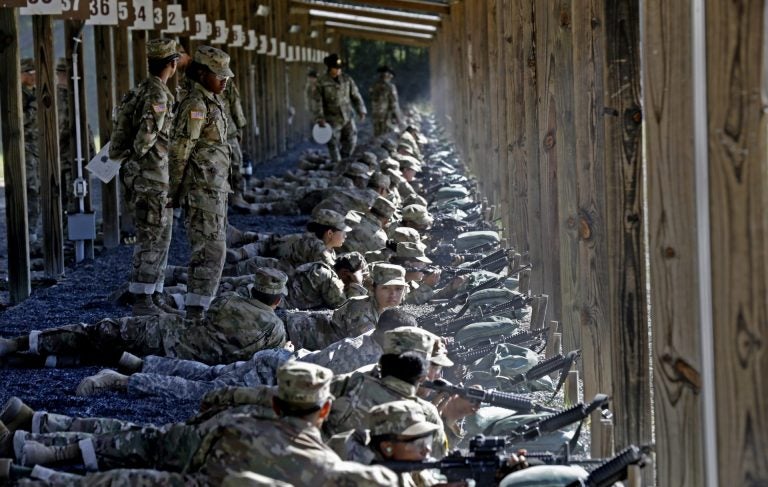Retired military leaders say Pa. schools need more money
A group of retired military leaders says too many young Pennsylvanians don’t meet standard eligibility requirements for serving in the armed forces.

FILE - In this Aug. 17, 2016, file photo, Army drill sergeants stand over recruits during a live-fire marksmanship training course at Fort Jackson, S.C. Under the gun to increase the size of the force, the Army is pouring an extra $200 million into bonuses this year to attract and retain soldiers, and has approved more drug use and conduct waivers for recruits in order to build the ranks. (Gerry Broome/AP Photo)
This article originally appeared on PA Post.
—
A group of retired military leaders says too many young Pennsylvanians don’t meet standard eligibility requirements for serving in the armed forces, and the country’s “thriving economy” makes the recruiting challenge even more difficult.
“Gaps in workforce readiness threaten our country’s future economic success and national security,” the group, Mission: Readiness, asserts in a new report released Tuesday.
The group’s proposed solutions include more funding for schools, high-quality care for infants and toddlers, and for pre-K programs. Stressed in the report is the need to do more to level the funding gaps between Pennsylvania’s richest and poorest school districts.
“Pennsylvania is home to the widest per-pupil spending gap in the nation between wealthy and poor school districts,” the report notes. “This gap has a very real impact on students. Pennsylvania’s wealthiest districts spend 33.5 percent more than its poorest school districts, a gap significantly higher than the national average of 15.6 percent.”
Mission: Readiness is part of the Council for a Strong America, a group of law enforcement, retired military, business, faith and sports leader who advocate on children’s issues.
The report does not suggest a specific dollar amount for the proposed funding increases. But the report says lawmakers need to do more to ensure young people in Pennsylvania are ready for college or careers, including military service.
“Nothing less than our economy and our national security depends on it,” retired Army Lt. Gen. Dennis Benchoff said Tuesday.
The report makes the case that young people aren’t leaving school with the skills they need, saying that about 7 in 10 people who are 17 to 24 years old don’t meet the military’s core eligibility requirements. The most common barriers include inadequate education, obesity or other disqualifying health conditions, or having a record of crime or substance use.
Military leaders and a bipartisan group of lawmakers, including Democratic Gov. Tom Wolf, spoke about the report’s findings during a Tuesday news conference at the Capitol in Harrisburg.
Wolf highlighted increased education funding during his administration. He said the most recent budget included increased funding that will allow for 465 new Head Start slots and 2,200 new Pre-K Counts slots. Wolf said, overall, pre-K-to-12 classroom funding increased by $1.2 billion over the last five years.
He said there’s a lot more work to do. But he didn’t offer any specific proposals to close the funding gaps that the report highlighted.
“I will continue to look for ways, again, in a bipartisan way to invest in education. …I have three more years in office,” Wolf said. “This is something that is not confined to one administration. This is something that I hope will continue. And I think it will.”
The funding challenges are big. The report states that more than 95,000 eligible 3- and 4-year-olds lack access to “high-quality pre-K programs.”
And while the report praises a new funding formula for public schools, passed by lawmakers in 2016, it notes that only about 10 percent of the state’s basic education funding subsidy goes through that formula.
To run all money through that formula — without cutting funding for any school districts — would require about $32 billion in increased basic education funding, a Keystone Crossroads analysis found in 2018.
Maj. Gen. Anthony Carrelli, who is responsible for National Guard units in Pennsylvania, said the state has increased recruiting efforts in recent years.
“Our recruiting force is probably at least twice as big as what it was four years ago just to essentially get the same number of people recruited,” Carrelli said, adding that the number of Pennsylvanians enlisting in the armed services has declined over the past 10 years. “It’s an alarming rate.”
The U.S Army missed 2018 recruiting goals by 8.5 percent, or about 6,500 recruits, according to the report. The report released Tuesday also points to survey results from the Pennsylvania Chamber of Business and Industry, which found “the lack of qualified applicants to fill job openings” is the “single most important issue” Pennsylvania business leaders say they face.
The commonwealth’s unemployment rate hit a record low of 3.8 percent in April and was just slightly higher, 4 percent, in September. Nationally, the unemployment rate was 3.5 percent the same month.
WHYY is your source for fact-based, in-depth journalism and information. As a nonprofit organization, we rely on financial support from readers like you. Please give today.




